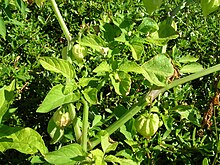| Physalis angulata | |
|---|---|

| |
| Cutleaf groundcherry | |
| Scientific classification | |
| Kingdom: | Plantae |
| Clade: | Tracheophytes |
| Clade: | Angiosperms |
| Clade: | Eudicots |
| Clade: | Asterids |
| Order: | Solanales |
| Family: | Solanaceae |
| Genus: | Physalis |
| Species: | P. angulata
|
| Binomial name | |
| Physalis angulata | |
| Synonyms[1] | |
|
List
| |
Physalis angulata is an erect herbaceous annual plant belonging to the nightshade family Solanaceae. Its leaves are dark green and roughly oval, often with tooth shapes around the edge. The flowers are five-sided and pale yellow; the yellow-orange fruits are borne inside a balloon-like calyx. The exact native range is uncertain.[2][3][4] The species may be naturally endemic to Australia[5] or the Americas[6] or the native range may encompass both the Americas and Australia.[7][5] It is now widely distributed and naturalized in tropical and subtropical regions worldwide.
The plant produces edible fruit that can be eaten raw, cooked, jammed, etc. However, all other parts of the plant are poisonous.[8] Members of the Toba-Pilagá ethnic group of Gran Chaco traditionally eat the ripe fruits raw.[9] Unripe raw fruits, flowers, leaves, and stems of the plant contain solanine and solanidine alkaloids that may cause poisoning if ingested by humans, cattle or horses.[10][11]
- ^ "Physalis angulata L." Plants of the World Online. Royal Botanic Gardens, Kew. Retrieved 10 February 2023.
- ^ "Factsheet - Physalis angulata (Wild Gooseberry)". keys.lucidcentral.org. Retrieved 31 January 2024.
- ^ Travlos, Ilias (7 January 2022). Physalis angulata (cutleaf groundcherry) (Report). doi:10.1079/cabicompendium.40711.
- ^ "Physalis angulata". keyserver.lucidcentral.org. Retrieved 31 January 2024.
- ^ a b "Factsheet - Physalis". www.flora.sa.gov.au. Retrieved 31 January 2024.
- ^ "Physalis angulata L. | Plants of the World Online | Kew Science". Plants of the World Online. Retrieved 31 January 2024.
- ^ "NT Flora". eflora.nt.gov.au. Retrieved 31 January 2024.
- ^ "Physalis angulata (cut-leaved ground-cherry): Go Botany". gobotany.nativeplanttrust.org. Retrieved 13 June 2021.
- ^ Arenas, Pastor; Kamienkowski, Nicolás Martín (December 2013). "Ethnobotany of the Genus Physalis L. (Solanaceae) in the South American Gran Chaco". Candollea. 68 (2): 251–266. doi:10.15553/c2012v682a9. hdl:11336/8358. ISSN 0373-2967.
- ^ "Physalis". North Carolina State University, Extension Gardener. 2023. Retrieved 23 February 2023.
- ^ "Ground cherry, Chinese lantern". Guide to Poisonous Plants, Colorado State University. 2022. Retrieved 23 February 2023.